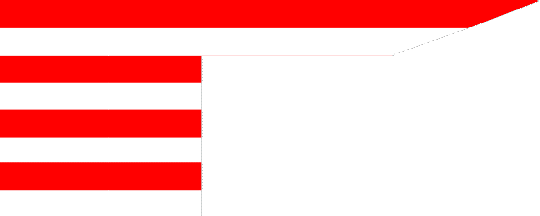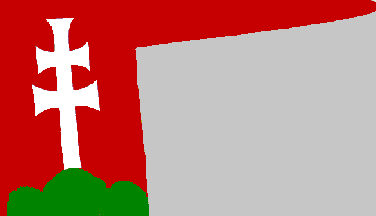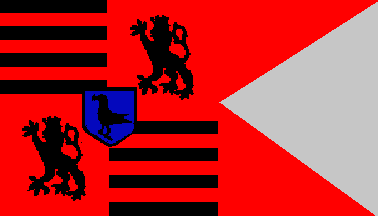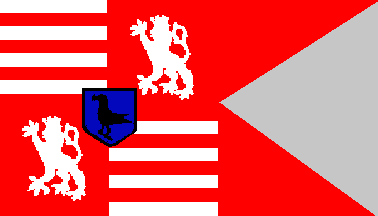
image by István Molnár

Last modified: 2014-05-22 by zoltán horváth
Keywords: hungary | arpad |
Links: FOTW homepage |
search |
disclaimer and copyright |
write us |
mirrors
See also:
Other Sites:
The flag of King (Saint) Stephen I King Saint Stephen, the
first king of Hungary reigned between 1000 and 1038. I saw it
also in Nagymaros opposite the Castle of Visegrád.
István Molnár, 7 January 2001

image by István Molnár, 24 November 2000
This flag was the flag of the Árpád House, the House of the
first Hungarian kings. It based on a picture on a stamp from
1981. The title is: Flag of the Árpád House in the 11th
century.
The first known member of the Árpáds was Prince Ügyek. His
son, Álmos and Álmos's son Árpád werethe leaders of the
Hungarians at the time of the Hungarian Conquest in the
Carpathian Basin at the end of the 9th century. The Árpáds
reigned in Hungary till 1301.
István Molnár, 24 November 2000
The flag with the "Arpad Stripes" was used by the
kings of the Arpad Dynasty 1000-1301 and see photos of genuine
flag of Prince Ferenc Rákóczi II., Prince of Transylvania
1704-1711, Commanding Prince of Hungary 1705-1711 at
"Hazatérés" Reformed Church at <www.geocities.com/hazateres/tortenel.html>.
Mikhail Revnivtsev, 29 October 2006
The stripes used by the kings of the Árpád House from the early 13th century (seals). The first mention of the flag with pictures you can see in the "Képes Krónika" (Vienna Illuminated Chronicle, Chronica Hungarorum , Chronicon (Hungariae) Pictum, Chronica Picta or Chronica de Gestis Hungarorum, see Wikipedia).
See paints:
- Battle
of Rozgony (14th century): The Hungarian Anjou flag win
- Battle
of Ménfo (11th century)
- St
Ladislaus and the Cumanian warrior (11th century)
- The tent
of Ladislaus II
- Siege of
Kraków
- The
wedding of Charles I (Anjou)
- King
Charles I. (Anjou)
- King
Saint Stephen (11th centry)
- The Árpád Stripes in Thuróczy, Iohannes: Chronica
Hungarorum, 1488 (1.2.3.4,5,6,7)
You can see the Árpád stripes: 7 divided red/silver or
red/white stripes. Red/white/red/white/red/white/red/white or
White/red/white/red/white/red/white/red. However, later the
stripes used in wrong form - for example flag of
Prince Rákóczi II.
You can see the Árpád Stripes on many city Coat of Arms. For
example: Esztergom, Banská Bystrica, Presov, Óbuda.
István Molnár, 19 December 2006

image by István Molnár, 1 June 2001
Yesterday I was in the Hungarian Institute & Museum of
Military History and I got 16 picture from Mrs. Csákvári,
Györgyi Kottra counsellor, chief museologist and head of
collection at the Military History Institute and Museum of the
Hungarian Army.
Original comment for the flag
"1 -2. Family and royal banner of the House of Árpád
(reconstruction). The two flags were reconstructed on the basis
of portrayals of the period. They follow the pattern of medieval
banners, the heraldic, rectangular flags. The textile parts
substitute for the escutcheons. The earlier one with the
patriarchal cross appeared during the reign of Béla III. As his
coat-of arms the king had chosen the patriarchal cross of
Byzantine origin, which was placed on the red escutcheon of the
Árpáds. The triple mound under the cross appeared later. The
red-argent striped flag appeared during the reign of Béla's
sons, Imre and András II, as a revival of the coats-of arms of
the previous kings. The flags and coats-of arms were used
parallel to each other throughout the Middle Ages by kings from
the House of Árpád and other dynasties in Hungary, as well. The
two coats-of arms have made up today's Hungarian national arms,
their colours are today's national colours."
István Molnár, 1 June 2001
More information on Árpád at <en.wikipedia.org>.
István Molnár, 5 April 2006
See also: Modern Political use of Flag with Arpad stripes

image by István Molnár and Peter Hans van den
Muijzenberg, 4 January 2010
At <www.magyarmult.externet.hu>,
you can find two pictures. On the first you can see King Charles
I, king of the Kingdom of Hungary with his Royal Coat of Arms. On
the second picture there is a Hungarian historical flag from the
14th century. On the picture is the Battle of Rozgony 1312.
Pictures from the Képes Krónika (Illustrated Chronicle) from
the 14th century.
István Molnár, 12 Febuary 2001
From <geocities.com/zaszlok/Muzeum>:
"3. Angevin (Anjou) royal banner, reconstruction - Banner
used during the reign of Charles Robert and Louis the Great, made
up of the family colours of the Angevins and Árpáds. The latter
symbolised the Angevins' legal claim to the throne."
King Charles (Robert) I. 1301-1342
King Louis (the Great) I. 1342-1382
István Molnár, 15 June 2001
Flag at "Book of All Kingdoms"

image by Eugene Ipavec, 29 December 2009
The 36th flag mentioned and illustrated in the Book of All
Kingdoms [e9s50] is attributed to
Hungary (Ungría). This as depicted in the 2005 spanish
illustrated transcription [e9s05],
a horizontally divided flag, the upper half blue semy of yellow
flaurs de lis and the bottom half filled with seven horizontal
stripes, alternating red and white, the latter thinner; flag in
the ogival default shape of this source.
The anonymous author of [e9s50]
describes the flag thusly: "E las seńales deste reinado es
un pendón a meitades, la una meitat con flores de Francia porque
es el rey de la Casa de Francia, e la otra meitad vandas bermejas
e blancas d’esta manera" (And the sign of this kingdom
is a halved pendon, one half with flowers of France because the
kingf os of the house of France, and the other half red and white
bars like this.).
This is the same design as the one above for Anjou Kings, only
differently depicted probably due to style contraints on the part
of the author of [e9s50].
António Martins-Tuválkin, 18 November
2007

image by Eugene Ipavec, 9 July 2010
On this Turkish picture from the 15-16th century you can see a
yellow-blue flag. On the picture there is the Great Victory at
Belgrade (Nándorfehérvár) in 1456. See <www.magyarmult.externet.hu>.
István Molnár, 12 Febuary 2001
This is a picture whose photo was sent by me two years ago
from the original at Topkapi Saray in Istanbul. Željko
suggested that it is how the artist thought a Christian flag
looks like but not a real flag that was viewed by him.
Dov Gutterman, 13 Febuary 2001
Maybe this flag relates to the flag (?) of János Hunyadi,
regent of Hungary. Here
is his Coat of Arms: Two fields are blue with black crow, two
fields are white with red lion.
István Molnár, 13 Febuary 2001
I think this flag is on the walls of Belgrade in 1456: <www.geocities.com/zaszlok>.
This is the flag of János (Johannes) Hunyadi, regent of Hungary.
István Molnár, 13 Febuary 2001
Here is the story of the Great Victory of János Hunyadi in
1456 - <www.thehistorynet.com>.
István Molnár, 27 Febuary 2001
A flag is visible in a 1584 Turkish miniature depicting the unsucessful 1456 Ottoman siege of Belgrade, pitting Hungarian nobleman John Hunyadi against
sultan Mehmet the Conqueror.
The flag is quartered yellow-blue, with a wide red cross separating the quarters and a the upper fly quarter extending as a "tail." Some Ottoman cavalry flags
are also shown (in the lower right), but not clearly.
Eugene Ipavec, 9 July 2010
John Hunyadi aka Hunyadi János in Hungarian and Sibinjanin Janko in Serbian,
his Latin name Ioannes Corvinus (also having variant names in other languages,
according to the custom of the period) shows clear link with the great Hungarian
ruling family of Corvins (he was father of the famous king Mathias Corvin).
This may simply be a variation or simplified depiction of the banner of arms of
Hunyadi - quartered azure a raven sable holding a golden ring in its beak and or
a lion rampant gules holding a crown or - i.e. quartered Hunyadi and Beszterce (German
Bistritz, archaic Nösen, now Bistriţa in Romania). In this case, the red cross
may be "invention" of the Ottoman artist (or not?), but in any case, the
swenkeled flag were apparently common in this era.
Željko Heimer, 9 July 2010
According to this contemporary
depiction, Huniady had quartered 1 and 4 azure, a raven sable holding a ring or in its beak, 2 and 3
AZURE, a lion rampant gules, holding a crown (or?) in its left paw. Note, though,
the border and separating lines or, and the lambrequins azure and or.
I don't know what credibility can we assign to a miniature painted more than a
century later.
Alex Danes, 9 July 2010
It's not so much credibility as it is a matter of historical interest... I
wonder if there are any depictions of the siege from the other side? Being a
Christan victory, there ought to heve been some gloating paintings.
Eugene Ipavec, 9 July 2010
See also: Black Army Flag

image by Istvan Molnar, 19 June 2001

image by István Molnár, 19 June 2001
The flag of the Black Army. The Black Army was the centre of
the mercenary force of King Mathias I.
From <www.geocities.com/zaszlok/Muzeum>:
"5. The so-called `Black Army' banner, reconstruction This
characteristic flag with a forked tail was reconstructed after a
miniature in Philostratus Chronicle, one of the Corvinas,
representing the 1485 entry of Corvin János, son of king
Matthew, into Vienna. The black colour of the flag used to be
white (argent) in fact, but the argent paint had become oxidised.
The reconstruction preserves the original colour."
I made two images. The traditional (black) and the original
(white (?)).
István Molnár, 19 June 2001
Shouldn't the bird in the heart shield be white also in the
second flag? This would be more in accordance with the heraldic
tincture rule. The fields represent Hungary (1 and 4) and Bohemia
(2 and 3).
Elias Granqvist, 20 June 2001
The heart shield is the Coat of Arms of the Hunyadi Family. On
the blue field there is the black crow on its mouth there is a
silver ring.
István Molnár, 20 June 2001
There is another reason why the bird remains black. As
Istvan said, it is the shield of the Hunyadi family, whose
members included one Governor of Hungary, one Regent of Hungary,
one Ban (Landowner/Lord type rank) of Transylvania, and one King
of Hungary. The bird on the shield is a raven, after a
story that the young Janos (John) Hunyadi was comissioned by his
mother, Erzsebet (Elizabeth) Szilagyi, to take a ring to the
then-King of Hungary and Holy Roman Emperor, Zsigmond (Sigismund)
of Luxembourg. She had been given this ring by him, during
one of his hunting trips in the are where she resided. On
the way to the royal court, young Hunyadi and a servant stopped,
andf he started napping. He was soon woken up by his
servant, being told that the ring had been taken by a crow, and
she was flying away with it in her bill. Hunyadi killed the
crow with his last arrow, and when he was given a coat of arms,
he chose to have a raven with a ring in its bill as his emblem.
Another small fact about this Coat of Arms: The Hunyadi
family's name in Latin is "Corvinus", meaning
"crow", or "raven". And King Matthias'
library, where the book covers all had the shield on them, was
known as the Corvina Library, second only to the Pope's. It
is also the name of one of the foremost publishing houses in
Hungary today.
Georges G. Kovari, 22 June 2001
János (John) Hunyadi (1406 - 23 October 1456), Ban (governor)
of Transylvania 1441-1446. Regent of Hungary 1446-1453
Mátyás (Mathias) Hunyadi (23 Febuary 1440 - 6 April 1490), King
of Hungary (1458-1490). Other name Mathias Corvinus.
Erzsébet Szilágyi was the wife of János Hunyadi and she was
the mother of King Mathias. No data about János Hunyadi's
mother. By a legend his mother was Erzsébet Morzsinai a daughter
of a Walachian voevod (kenéz!) and his father was King Sigismund
(king of Hungary 1387-1438). The fact: Vajk, a Walachian noble,
royal warrior got the tenure and castle of Hunyad in 1409, when
János was 3 years old. Vajk of Hunyad (he had got the family
name about the castle) had got another son. This boy was named
János too (!!!!) You can see the tomb of the two brother (the
two János Hunyadi) in the Roman Catholic cathedral of Alba Iulia
city (Alba county, Romania; its Hungarian name: Gyulafehérvár).
The young János Hunyadi became one of the richest lords of
Hungary. His fantastic castle you can see in Hunedoara city
(Hunedoara county, Romania; its Hungarian name: originally
Hunyadvár - from the 15th century Vajdahunyad)
The legend of the ring, crow etc. - The crow holding a ring in
its mouth is in a legend about the descend of Hunyadi János
(John of Hunyad), father of King Mathias, governor of Hungary,
the victorious hero of the siege of Nándorfehérvár (Belgrade)
in 1456. By the legend his father, King Sigismund, King of
Hungary, Emperor of the Holy Roman Empire (Germany) fell in love
with a young Transylvanian (Walachian) girl. To remember this
love the king gave a ring to the girl. The girl, who was the
daughter of a Transylvanian Boyar bore a boy. When the little
child, Jankula played on the yard of the House of the Morzsinai
Family a crow stole the ring. The mother of Jankula was
frightened and his brother shot the crow. The girl went to the
king to remind him of their love and to show him their child. The
king took upon himself to bring up the young boy. After a month
the king gave a Coat of Arms to the Morzsinai Family (a crow
holding a ring in its mouth) and a great tenure in Transylvania,
in Hunyad. The boy lived in the Castle of Hunyad and was given
him the name: Hunyadi.
This is a short reconstruction of the legend...
István Molnár, 22 June 2001
I do not want to look like a conceited person, but let me tell
my own family history on my maternal side. By mother's maiden
name is Marussy, and there is a family tradition that Marussy is
a Hungarized version of the Cumanian name Morzsinai, and that we
are descendants of the brother of Morzsinai Erzsebet, so we have
a blood relationship connection to the Hunyadi family. Our family
tradition also say that the Morzsianai/Marussy clan is not of
Vlachian origin, but of Cumanian origin. They came to Hungary
from Moldva in the 14th century. The original letter of nobility
dated from the 17th century is in the posession of my mother's
cousin, it says "it is issued to certify that Marussy Andras
is already a noble". The nobility prename of the family is
fehervari (de Alba Iulia), so there is a big coincidence. Of
course there is no proof for this, maybe the family tradition is
fake, I don't know.
Ivan Marinov, 22 June 2001
In the 15th century the word Walachian didn't means Walachian
ethnicity but origin from Walachia (now southern part of
Romania). Before the Mongol Invasion the territory was under
Cumanian rule. It could be the nobles were Cumanians by origin in
the 15th century...
István Molnár, 22 June 2001

image by István Molnár, 3 August 2001
(photo taken at the Castle of Lendava/Lendva, Slovenia)
Nicholaus Zrínyi (1620-1664), In Hungarian: Zrínyi Miklós,
Hungarian lord, general, Hungarian poet. In Croatian: Nicola
Zrinski, Croatian-Hungarian lord, general, Croatian poet In Latin
(the official language of the Kingdom of Hungary): Nicolaus a
Zrini, The family has got its family name from the Castle of
Zrin(y). Their original name was Subič. Nicholaus Zrínyi wrote
the famous Hungarian epic: "A szigeti veszedelem" about
his great-grandfather, Nicholaus Zrínyi's battle at Szigetvár
1566. From a Croatian page about the Zrínyi - Zrinski family -
(flag is "Nicola VII"s flag) at <www.hr>:
"...Nikola VII, like his father, before him, was famous for
his heroism and education. The Franciscans in Cakovec owe him
special gratitude since he was the man who established the
Franciscan order in Cakovec. There is still a portrait of Juraj
[gyo'rgy] at the Franciscan monastery with a Latin inscription in
its upper corner: "Com. Nicolaus a Zrinio Regn. Dalm. Croat.
Et Slav- Banus ac PP Franciscanorum Prov. S. Ladislai Chaktorn,
introductor et illocator Ao 1659" (Prince Nikola Sdrinia,
the Viceroy of Dalmatian, Croatian and Slavonian Kingdom, the man
who introduced the Franciscan fathers of St. Ladislav's province
to Cakovec in 1659). Due to his heroic acts (the Turks were
scared away from Kanjiza forever; the Drava bridge at Osijek was
burnt down) he became a Viceroy of Croatia and was respected and
appreciated throughout Europe. Nikola was also famous as a poet
and a polyglot - he spoke seven languages; in 1651, he wrote
"Adriai Tengernek Syrenaia" (Adriatic Sea Murmaid) in
Hungarian. Besides other poems, it contains the heroic epics on
the battle of Siget and Nikola of Siget's death. After the peace
treaty at Vasvar was concluded, he became the central figure of
the Zrinski - Frankopan plot, but not for long, since he was
killed by a wounded boar (?) while hunting at Kursanecki Lug on
the 18th November 1664. "
The flag in my site can be seen here
and here.
István Molnár, 3 August 2001

image from <www.khvm.hu>,
located by István Molnár
Just found this picture on the page of the Ministry of
Transport and Water Management of the Hungarian Republic (KVM).
The picture is a link to the Museums (the title is: Post Office
Museum Hollókő village).
The flag is an old flag, maybe from the years of the Prince
Rákóczi's War of Independence. I didn't find anything about
this picture. At the time of the war such flags were used.
Prince Francis Rákóczi II was the Reigning Prince of
Transylvania and the "Commanding Prince" of Hungary,
who was the leader the Anti-Habsburgian Independence war
1703-1711 in Hungary. It could be used between in this era.
"CUM DEO PRO PATRIA ET LIBERTATE" was the inscription
on the flags at the time of Prince Rákóczi's War of
Independence.
István Molnár, 23 November 2000 and 27 March 2001
Latin for "With God for Country and Freedom".
Elias Granqvist, 27 March 2001
Old flag with the Coat of Arms of the Rakoczi family from the
17-18th century is at <www.tarnok.hu>.
The Rákóczi family gave some Transylvanian princes and Francis
Rákóczi II the leader prince of the independence war 1703-1711.
István Molnár, 30 August 2001
Flag from 1703-1711
Rákóczi's Revolt at <www.historicaltextarchive.com>.
Flag of the Prince
Rákóczi II's war in 1706 is at <mek.oszk.hu>.
István Molnár, 6 January 2002 and 26 January 2006
Yesterday I was in the Nemzeti Múzeum (HNM) and take some
photos of the flag of Prince Ferenc Rákóczi II. (Click 1,2,3 to see the photos).
István Molnár, 5 February 2006
Here is a photo of
Military flag 1838 type (used in Hungary).
István Molnár, 24 January 2002
On <www.sulinet.hu/T246.HTM>:
The crowning ceremony of King Leopold I. on 27th June 1665. in
Pozsony (Pressburg, now Bratislava). You can see two flags with
the Hungarian Coat of Arms a flag with Croatian and a flag with
Dalmatian Coat of Arms (?).
On <www.sulinet.hu/T252T.HTM>:
The crowning ceremony of King Leopold II. on 15th November 1790.
in Pozsony (Pressburg, now Bratislava). You can see some flags
and you can see the Hungarian colours in use.
On <www.sulinet.hu/T253T.HTM>:
The crowning ceremony of King Ferdinand V. on 28th September
1830. in Pozsony (Pressburg, now Bratislava). You can see some
flags and you can see the Hungarian colours in USE. Crowning flag
of Hungary at <www.sulinet.hu/M14.JPG>.
Crowning flag of Cumania at <www.sulinet.hu/M13.JPG>.
Crowning flag of Bulgaria at <www.sulinet.hu/M12.JPG>.
Do you know more information about theses pictures?
István Molnár, 8 June 2001
These coronation flags, as they are called, were used only on
coronation ceremonies in Bratislava, and thogh they are an
important relict showing the Croatian statehood continuity there
seems to be quite little resarched. However, two of such are
preserved in Croatian Historical Museum, one from 1830 and an
other from 1867. There is a short article obout those flags in
the exhibition catalogue of the flag exhibition held in the
museum few years ago. Even if the article is very much
concentrated to Croatian flags only, it may give few hints on
their use and history. There are also few references to some
Slovakian sources. They may then give us more info, and I don't
doubt that there is also extensive Hungarian literature about the
coronations that would encompass flags, too. I would guess that
some more examples of those flags are preserved in museums of
Hungary and slovakia (and more somewhere else?).
Željko Heimer, 9 June 2001
I have contacted Mrs. Jelena Borosak-Marjanovic from Croatian
Historical Museum (cf. [bor96])
regarding the big difference in design of the coronations flags
that are preserved in CHM and those displayed in St. Mathias
church in Budapest. As I have suggested this may be due (among
other possibilities) that those in St. Mathias church are not the
coronation flags from the event, but might be replicas made at
some latter point. Mrs. Borosak-Marjanovic is inclined to agree
with that assumption, and suggest that this might happened while
the church was renovated in 1874-1896.
Željko Heimer, 19 June 2001
It seems that Željko is right. The facts are I
have got a picture: "Historical flags on the Mathias
Church." and I have got an information from the church:
"On the church there are only coronation flags from
1867"
Pictures and descriptions from her on <www.geocities.com/zaszlok/Muzeum>.
István Molnár, 19 June 2001
You can see there:
http://esterhazy.at/images/uploads_930/7/e/1/673761/KrnungsfahneHU2_1362732131507427_v0_h.jpg
http://esterhazy.at/images/uploads_h600/4/7/a/1348730/1frakno_v0_h.jpg
http://esterhazy.at/hu/fraknovara/673761/J-Gyztes-csatk-s-koronzsok?_vl_backlink=%2Fhu%2Findex.do
This flag symbolised Hungary on the coronation ceremony in 1618. You can see
more coronation flag in the Esterházy Castle of Fraknó (Burg Forchtenstein):
Croatia 1647, Serbia 1647
More flags:
http://esterhazy.at/images/uploads_930/e/1/5/761365/Standardenfahne_Paul_I_Esterhazy_1699.jpg
István Molnár, 08 April 2013
I've been looking through their pages, but it seems that the English version
hardly mentions the flag, the german version has a bit, but I can really not
found them more then you provided... Are there any images of the 1647 flags?
(From what you wrote, it seems that I shall have to drive there to see them.
If anyone gets something more on the two 1647 mentioned, let me know .
On coronation flags (including these 1618), see
this page.
Eventually - we should end up with the list of where all those flags from
various coronation ceremonies are nowadays (if preserved). It seems obvious that
the flags were as a rule kept by those who carried them in the ceremony, so they
either ended up in their family collections or found their way to museums... or
got lost in time...
Željko Heimer, 13 April 2013
Flying historical flags in
Hódmezövásárhely. Elements of nowadays Coat of Arms (the
historical small Coat of Arms). You can see the original flags at
<www.geocities.com/tortenel.html>.
István Molnár, 1 March 2001
Election flag for Móric Szentkirályi and Lajos Kossuth in
1847. Móric Szentkirályi and Lajos Kossuth became the deputies
of Pest county in 1847 to the Parliament.
More information about Lajos Kossuth at http://en.wikipedia.org/wiki/Lajos_Kossuth
Source: Képes Történelem, Haza és Haladás; Budapest 1977.
István Molnár, 10 March 2006